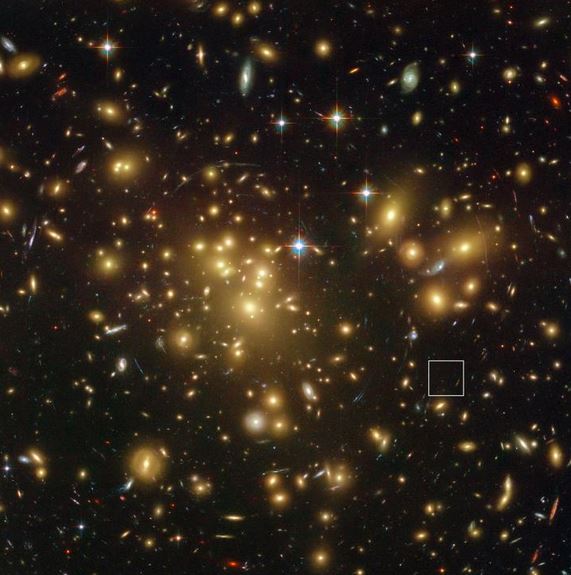A team of European astronomers observed one of the youngest and remotest galaxies ever found, and were surprised at how mature it was. Its concentration of dust was a fraction of very mature galaxies, such as the Milky Way, but it already had many stars and significant quantities of metals.
The scientists, from Denmark, Sweden, UK, France and Italy, used the Very Large Telescope’s X-shooter Instrument and the Atacama Large Millimeter/submillimeter Array to observe the c. 700 million year-old galaxy.
They were able to observe the galaxy, called A1689-zD1, because of its brightness being amplified more than nine times by a gravitational lens in the form of a huge galaxy cluster, Abell 16989, which is located between the Earth and the young galaxy.

This view from the NASA/ESA Hubble Space Telescope shows the rich galaxy cluster Abell 1689. The huge concentration of mass bends light coming from more distant objects and can increase their total apparent brightness and make them visible. A1689-zD1, is in the box. It is so faint it is barely seen in this picture. (Image: NASA/ESA)
Without the galaxy cluster’s gravitational boost, the glow would have been too weak to detect.
What is gravitational lensing?
Gravitational lensing occurs when the light from a distant object is distorted around a massive object, such as a huge galaxy, between the viewer and the distant object.
Gravitational lensing was one of the predictions in Einstein’s theory of general relativity. Galaxy clusters are the Universe’s largest structures. Their gravitational force is so powerful that they warp the spacetime around them.
The researchers said we can see the distant galaxy when it was at 5% of its present age. It is far away, and takes several billions of years for its light to reach us.
It is a relatively modest system – much smaller and less luminous than several other objects that have been studied at this stage in the early Universe, and therefore a more typical example of a galaxy at that time.
The galaxy is being observed as it was during the period of reionization, when the first stars lit up an immense and transparent Universe and ending the extended stagnation of the Dark Ages.
A young and precocious galaxy
The scientists had expected A1689-zD1 to look like a newly formed system. They were surprised by the abundance of interstellar dust and its rich chemical complexity.
Study leader, Associate Professor Darach Watson, from the University of Copenhagen, said:
“After confirming the galaxy’s distance using the VLT. We realised it had previously been observed with ALMA. We didn’t expect to find much, but I can tell you we were all quite excited when we realised that not only had ALMA observed it, but that there was a clear detection.”
“One of the main goals of the ALMA Observatory was to find galaxies in the early Universe from their cold gas and dust emissions – and here we had it!”
Even though this galaxy was a cosmic infant, it proved to be precocious. One would not expect it, at such a young age, to have heavier chemical elements – anything heavier than helium or hydrogen, defined in astronomy as metals. These are produced deep inside stars and scattered once they explode or otherwise die.
This process has to be repeated for several stellar generations to produce significant amounts of heavier elements such as nitrogen, oxygen and carbon.
Significantly, the young galaxy appeared to be emitting a lot of radiation in the far infrared, suggesting it had already produced many of its stars and considerable quantities of metals “and revealed that it not only contained dust, but had a dust-to-gas ratio that was similar to that of much more mature galaxies.”
Prof. Watson said:
“Although the exact origin of galactic dust remains obscure, our findings indicate that its production occurs very rapidly, within only 500 million years of the beginning of star formation in the Universe – a very short cosmological time frame, given that most stars live for billions of years.”
According to their findings, this juvenile galaxy has been forming stars consistently at a moderate rate since 560 million years after the Big Bang, if not, it passed through its period of starburst incredibly rapidly before entering a declining state of star formation.
Co-author, Kirsten Knudsen, from Chalmers University of Technology in Sweden, added:
“This amazingly dusty galaxy seems to have been in a rush to make its first generations of stars. In the future, ALMA will be able to help us to find more galaxies like this, and learn just what makes them so keen to grow up.”
Citation: “A dusty, normal galaxy in the epoch of reionization,” Darach Watson, Lise Christensen, Kirsten Kraiberg Knudsen, Johan Richard, Anna Gallazzi and Michał Jerzy Michałowski. European Southern Observatory.

